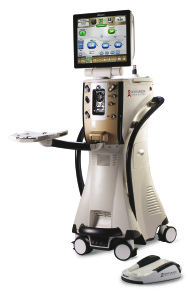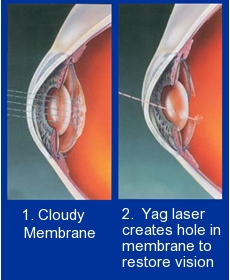Cataract surgery is the removal of the cloudy natural lens of the eye with artificial lens replacement. It is the most commonly performed eye surgery. Each year, over 14 million cataract and lens implant procedures are performed worldwide. This proven procedure allows the intraocular lens to be implanted in a brief (about 15-20 minutes) outpatient procedure.
Cataract and lens implant surgery today is highly successful and very precise. There are different types of specialty or premium lens implant technologies to meet individual eye health and lifestyle needs. While most patients are candidates for a standard monofocal or premium multifocal lens our doctors may recommend a specific type of lens implant based upon your eye health and lifestyle.
Laser Cataract Surgery Explained
Millions of Americans suffer from cataracts. One in three, mostly older Americans, will have the surgery at some point in their lives. The surgery is performed to remove the natural lens of the eye after it has become clouded over time. To restore focus, a permanent artificial lens is then implanted.
Traditional cataract surgery has always involved the use of a surgical blade, used by hand, to create several small incisions in the eye. A bent needle or forceps is used to make an opening in the cataract outer membrane, which is referred to as the capsulotomy. With Laser Assisted Cataract Surgery, these incisions and the opening in the cataract membrane are now made by a laser. This technology allows Dr. Moretsky, Dr. Cassidy and Dr. Stock to plan and perform various parts of the cataract surgery with laser precision. The laser also softens the central core of the cataract permitting easier removal of the cataract. Ultrasonic energy has traditionally been used to remove the core, but now with laser assisted cataract surgery, the amount of ultrasonic energy necessary can be reduced and often eliminated. This results in less damage to the intraocular structures.
With laser assisted cataract surgery, Dr. Moretsky, Dr. Cassidy and Dr. Stock will create a precise computerized surgical plan and utilize an integrated advanced technology guidance system. The goal is to create incisions, an opening in the cataract membrane, and softening of the cataract core with real time advance imaging, controlled and guided by the surgeon. Although Dr. Moretsky, Dr. Cassidy and Dr. Stock have each performed over 30 thousand cataract surgeries, the addition of the laser, the computer guidance, and integrated advanced imaging enables the doctors to obtain even more predictable surgical outcomes.
The laser can also be employed to plan, locate, and perform precise incisions on the cornea to customize treatment of astigmatism during cataract surgery. For patients who are seeking glasses independence, the laser may be utilized to improve their outcome in conjunction with advance technology intraocular lenses, both for those with cataracts and those without cataracts who are interested in Refractive Lens Exchange (RLE).
Moretsky Cassidy Vision Correction is proud to be one of the first centers in Arizona to perform laser assisted cataract surgery to offer our patients what they deserve in their cataract surgery – The Best.
Standard Cataract Surgery Explained
One of the safest and most successful procedures performed today, cataract surgery only takes approximately 15-20 minutes and is scheduled as an outpatient procedure. Patients generally return to daily activities quickly.

Doctor Moretsky and Doctor Cassidy utilize the most current technology for standard cataract extraction with intra ocular lens implantation surgery: the Alcon Centurion System. Unlike all other cataract removal systems, this new improved version relies on “Active Fluidics” which simply means the pressure in the eye is more accurately maintained, permitting better surgeon control during the cataract removal process. Rather than using gravity to allow fluid to enter the eye as in traditional cataract surgery equipment, here fluids used to remove the cataract are pumped into the eye by a specialized computer guided compression device. Other features include “Autosert”, which allows the surgeon to utilize a highly accurate computer automated method to insert the intraocular lens into the eye, rather than the traditional hand controlled method. There are other unique features to the Centurion System, such as “Balanced Energy” which enhances cataract removal efficiency, and “Applied Integration” which is designed to integrate with other Alcon technologies, all of which make the Centurion stand out as the most advanced cataract system available today.
Cataract
Step 1Your eye will be prepared with anesthetic prior to the procedure so you’ll feel little, if any, discomfort. |
|
Step 2A tiny incision is made to allow a small instrument (about the size of a pen tip) to break up the cloudy cataract. |
 |
Step 3A standard or premium intraocular lens implant is inserted through same tiny incision. |
 |
Step 4A standard or premium intraocular lens implant is unfolded and set into its permanent position. |
 |
What is an After Cataract?
A condition called posterior capsule opacification is treated with a technique called the YAG laser capsulotomy. The procedure is safe, brief, and provides immediate vision improvement. The laser creates a hole in the cloudy capsule (2).

After Cataract Surgery
You’ll need prescription eye drops to guard against infection and a follow-up visit within 24 hours.
Most patients resume normal activities the next day.
Learn More
Check out the different eye cataract treatment options
See what others say about having cataract eye surgery
Read about the research about Moretsky Cassidy Vision Correction in Forbes Magazine





